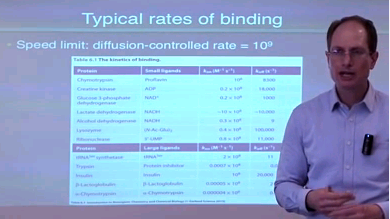UCI Chem 128 Introduction to Chemical Biology (Winter 2013)
Lec 12. Introduction to Chemical Biology -- Protein Functions
View the complete course: ../courses/chem_128_introduction_to_chemical_biology.html
Instructor: Gregory Weiss, Ph.D.
License: Creative Commons BY-NC-SA
Terms of Use: ../info.
More courses at http://ocw.uci.edu
Description: This video is part of a 18-lecture undergraduate-level course titled "Introduction to Chemical Biology" taught at UC Irvine by Professor Gregory Weiss. Introduction to the basic principles of chemical biology: structures and reactivity; chemical mechanisms of enzyme catalysis; chemistry of signaling, biosynthesis, and metabolic pathways.
Introduction to Chemical Biology (Chem 128) is part of OpenChem: ../openchem
Recorded February 15, 2013.
Index of Topics:
Announcements
0:01:03 - Week 7 Overview
0:02:56 - Announcements
0:04:20 - Writing a Chemical Biology Proposal (EEE Website)
0:13:46 - Office Hours
Lecture
0:14:15 - Enzymes In The News
0:15:32 - Our Story to Date on Tuesday...
0:18:28 - All B-Sheet Proteins
0:21:12 - Immunoglobulin Dominates for Scaffolding and Molecular Recognition
0:22:42 - All B-Sheet Proteins (revisited)
0:27:13 - WD Proteins Scaffold Together Large Assemblies
0:28:12 - Collagen is Formed From a 3-Stranded Coil
0:29:21 - All a-Helical Proteins
0:31:40 - a/B Proteins
0:32:10 - Repeat Proteins
0:32:45 - Repeat Proteins, Slide 2
0:33:21 - Peptide Binding Domains
0:34:02 - Peptide Binding Domains, Slide 2
0:34:49 - Peptide Binding Domains, Slide 3
0:36:48 - Peptide Binding Domains, Slide 4
0:39:05 - Higher Order Assemblies of Proteins
0:41:23 - Equilibrium Constants to Describe the Strengths of Non-Covalent Interactions
0:43:47 - Rapamycin and FK506 Bind to FKBP to Form a Composite Surface
0:45:01 - Examples of Non-Covalent Receptor-Ligand Interactions
0:46:54 - Following the Speeds of Reactions
0:49:25 - Rates of Non-Covalent Interactions
0:50:16 - Typical Rates of Binding
0:53:09 - Measuring Biological Potency Through Dose Response Curve
0:56:26 - Measuring Biological Response by ELISA
0:57:43 - How to Run an ELISA
0:59:36 - Steptavidin-Biotin Offers Near Covalent Binding Affinity
1:00:39 - Biotinylated Reagents Used Extensively in Chemical Biology
1:02:46 - Isolating Targets Using Biotinylated Probes
1:03:47 - Enzymatic Catalysts = Catalytic Receptors
1:05:39 - Enzymes Work By Stabilizing & Thus Lowering the Energy of Transition States
1:08:32 - Example of Enzymatic Catalysis
1:10:55- Inhibiting Enzymes by Mimicking the Transition State of the Reaction
Required attribution: Weiss, Gregory Introduction to Chemical Biology 128 (UCI OpenCourseWare: University of California, Irvine), ../courses/chem_128_introduction_to_chemical_biology.html. [Access date]. License: Creative Commons Attribution-ShareAlike 3.0 United States License.



